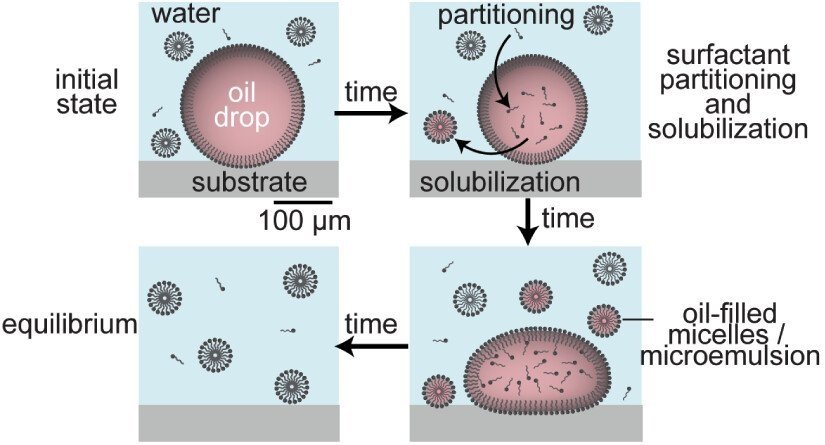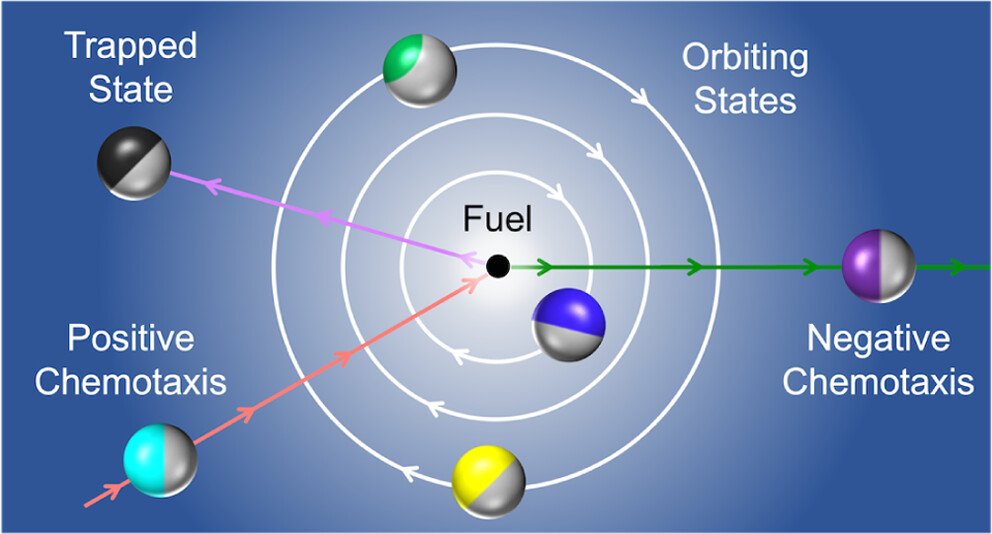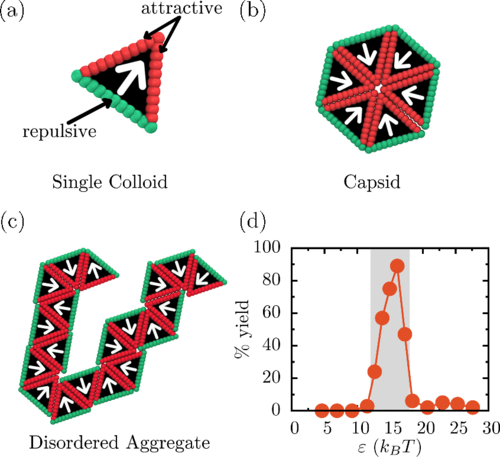
Research Publications
-

Sedimentation equilibrium as a probe of the pressure equation of state of active colloids
Choi, Y., Schiltz-Rouse, E., Bayati, P., & Mallory, S. A. (2025). Sedimentation equilibrium as a probe of the pressure equation of state of active colloids. arXiv preprint arXiv:2506.17428.
We introduce a theoretical and computational framework for extracting the pressure equation of state (EoS) of an active suspension from its steady-state sedimentation profile. As EoSs are prerequisites for many theories in active matter, determining how pressure depends on key parameters such as density, activity, and interparticle interactions is essential to make quantitative predictions relevant to materials design and engineering applications. Focusing on the one-dimensional active Brownian particle (1D-ABP) model, we show that the pressure measured in a homogeneous periodic system can be recovered from the spatial profiles established in sedimentation equilibrium. Our approach is based on exact mechanical considerations and provides a direct route for determining pressure from experimentally measurable quantities. This work compares sedimentation-derived equations of state with those obtained from periodic simulations, establishing a foundation for using sedimentation as a generic tool to characterize the behavior of active suspensions.
-

Single-file diffusion of active Brownian particles
Akintunde, A., Bayati, P., Row, H., & Mallory, S. A. (2025). Single-file diffusion of active Brownian particles. The Journal of Chemical Physics, 162 (16).
Single-file diffusion (SFD) is a key mechanism underlying transport phenomena in confined physical and biological systems. In a typical SFD process, microscopic particles are restricted to moving in a narrow channel where they cannot pass one another, resulting in constrained motion and anomalous long-time diffusion. In this study, we use Brownian dynamics simulations and analytical theory to investigate the SFD of athermal active Brownian particles (ABPs)—a minimal model of active colloids. Building on prior work [Schiltz-Rouse et al., Phys. Rev. E 108, 064601 (2023)], where the kinetic temperature, pressure, and compressibility of the single-file ABP system were derived, we develop an accurate analytical expression for the mean square displacement (MSD) of a tagged particle. We find that the MSD exhibits ballistic behavior at short times, governed by the reduced kinetic temperature of the system. At long times, the characteristic subdiffusive scaling of SFD, [⟨(Δx)2⟩∼ t1/2], is preserved. However, self-propulsion introduces significant changes to the 1D-mobility, which we directly relate to the system’s compressibility. Furthermore, we demonstrate that the generalized 1D-mobility, originally proposed by Kollmann for equilibrium systems [M. Kollmann, Phys. Rev. Lett. 90, 180602 (2003)], can be extended to active systems with minimal modification. These findings provide a framework for understanding particle transport in active systems and for tuning transport properties at the microscale, particularly in geometries where motion is highly restricted. -

Dynamic Partitioning of Surfactants into Nonequilibrium Emulsion Droplets
Balaj, R. V., Xue, W., Bayati, P., Mallory, S., & Zarzar, L. D. (2024). Dynamic Partitioning of Surfactants into Nonequilibrium Emulsion Droplets. Journal of the American Chemical Society, 146(38), 26340-26350.
Characterizing the propensity of molecules to distribute between fluid phases is key to describing chemical concentrations in heterogeneous mixtures and the corresponding physiochemical properties of a system. Typically, partitioning is studied under equilibrium conditions. However, some mixtures form a single phase at equilibrium but exist in multiple phases when out-of-equilibrium, such as oil-in-water emulsion droplets stabilized by surfactants. Such droplets persist for extended times but ultimately disappear due to droplet dissolution and micellar solubilization. Consequently, equilibrium properties like oil–water partition coefficients may not accurately describe out-of-equilibrium droplets. This study investigates the partitioning of nonionic surfactants between shrinking microscale oil droplets and water under nonequilibrium conditions. Quantitative mass spectrometry is used to analyze the composition of individual microdroplets over time under conditions of varying surfactant composition, concentrations, and oil molecular structures. Within minutes, nonionic surfactants partition into oil droplets, reaching a nonequilibrium steady-state concentration that can be over an order of magnitude higher than that in the aqueous phase. As the droplets solubilize over hours, the surfactants are released back into water, leading to transiently high surfactant concentrations near the droplet–water interface and the formation of a microemulsion phase with a low interfacial tension. Introducing ionic surfactants that form mixed micelles with nonionic surfactants reduces partitioning. Based on this observation, stimuli–responsive ionic surfactants are used to modulate the nonionic surfactant partitioning and trigger reversible phase separation and mixing inside binary oil droplets. This study reveals generalizable nonequilibrium states and conditions experienced by solubilizing oil droplets that influence emulsion properties.
-

Orbits, Spirals, and Trapped States: Dynamics of a Phoretic Janus Particle in a Radial Concentration Gradient
Bayati, P., & Mallory, S. A. (2024). Orbits, spirals, and trapped states: Dynamics of a phoretic Janus particle in a radial concentration gradient. ACS nano.
A long-standing goal in colloidal active matter is to understand how gradients in fuel concentration influence the motion of phoretic Janus particles. Here, we present a theoretical description of the motion of a spherical phoretic Janus particle in the presence of a radial gradient of the chemical solute driving self-propulsion. Radial gradients are a geometry relevant to many scenarios in active matter systems and naturally arise due to the presence of a point source or sink of fuel. We derive an analytical solution for the Janus particle’s velocity and quantify the influence of the radial concentration gradient on the particle’s trajectory. Compared to a phoretic Janus particle in a linear gradient in fuel concentration, we uncover a much richer set of dynamic behaviors including circular orbits and trapped stationary states. We identify the ratio of the phoretic mobilities between the two domains of the Janus particle as a central quantity in tuning their dynamics. Our results provide a path for developing optimum protocols for tuning the dynamics of phoretic Janus particles and mixing fluid at the microscale. In addition, this work suggests a method for quantifying the surface properties of phoretic Janus particles, which have proven to be challenging to probe experimentally.
-

Kinetic temperature and pressure of an active Tonks gas
Schiltz-Rouse, E., Row, H., & Mallory, S. A. (2023). Kinetic temperature and pressure of an active Tonks gas. Physical Review E, 108(6), 064601.
Using computer simulation and analytical theory, we study an active analog of the well-known Tonks gas, where active Brownian particles are confined to a periodic one-dimensional (1D) channel. By introducing the notion of a kinetic temperature, we derive an accurate analytical expression for the pressure and clarify the paradoxical behavior where active Brownian particles confined to 1D exhibit anomalous clustering but no motility-induced phase transition. More generally, this work provides a deeper understanding of pressure in active systems as we uncover a unique link between the kinetic temperature and swim pressure valid for active Brownian particles in higher dimensions.
-

Mechanical Theory of Nonequilibrium Coexistence and Motility-Induced Phase Separation
Omar, A. K., Row, H., Mallory, S. A., & Brady, J. F. (2023). Mechanical theory of nonequilibrium coexistence and motility-induced phase separation. Proceedings of the National Academy of Sciences, 120(18), e2219900120.
Nonequilibrium phase transitions are routinely observed in both natural and synthetic systems. The ubiquity of these transitions highlights the conspicuous absence of a general theory of phase coexistence that is broadly applicable to both nonequilibrium and equilibrium systems. Here, we present a general mechanical theory for phase separation rooted in ideas explored nearly a half-century ago in the study of inhomogeneous fluids. The core idea is that the mechanical forces within the interface separating two coexisting phases uniquely determine coexistence criteria, regardless of whether a system is in equilibrium or not. We demonstrate the power and utility of this theory by applying it to active Brownian particles, predicting a quantitative phase diagram for motility-induced phase separation in both two and three dimensions. This formulation additionally allows for the prediction of novel interfacial phenomena, such as an increasing interface width while moving deeper into the two-phase region, a uniquely nonequilibrium effect confirmed by computer simulations. The self-consistent determination of bulk phase behavior and interfacial phenomena offered by this mechanical perspective provide a concrete path forward toward a general theory for nonequilibrium phase transitions.
-

Dynamic Overlap Concentration Scale of Active Colloids
Mallory, S. A., Omar, A. K., & Brady, J. F. (2021). Dynamic overlap concentration scale of active colloids. Physical Review E, 104(4), 044612.
By introducing the notion of a dynamic overlap concentration scale, we identify universal and previously unreported features of the mechanical properties of active colloids. These features are codified by recognizing that the characteristic length scale of an active particle’s trajectory, the run-length, introduces a new concentration scale φ* . Large-scale simulations of repulsive active Brownian particles (ABPs) confirm that this new run-length dependent concentration, which is the trajectory-space analogue of the overlap concentration in polymer solutions, delineates distinct concentration regimes in which interparticle collisions alter particle trajectories … -

The "isothermal" compressibility of active matter
Dulaney, A. R., Mallory, S. A., & Brady, J. F.
2021 - The Journal of Chemical Physics, 154(1), 014902.We demonstrate that the mechanically-defined "isothermal" compressibility behaves as a thermodynamic-like response function for suspensions of active Brownian particles. The compressibility computed from the active pressure - a combination of the collision and unique swim pressures - is capable of predicting the critical point for motility induced phase separation, as expected from the mechanical stability criterion …
-

Universal reshaping of arrested colloidal gels via active doping
Mallory, S. A., Bowers, M. L., & Cacciuto, A.
2020 - The Journal of Chemical Physics, 153(8), 084901.
Colloids that interact via a short-range attraction serve as the primary building blocks for a broad range of self-assembled materials. However, one of the well-known drawbacks to this strategy is that these building blocks rapidly and readily condense into a metastable colloidal gel. Using computer simulations, we illustrate how the addition of a small fraction of purely repulsive self-propelled colloids, a technique referred to as active doping, can prevent the formation of this metastable gel state and drive the system toward its thermodynamically favored crystalline target structure … -

Activity-enhanced self-assembly of a colloidal kagome lattice
Mallory, S. A., & Cacciuto, A.
2019 - Journal of the American Chemical Society, 141(6), 2500-2507.
Here, we describe a method for the enhanced self-assembly of triblock Janus colloids targeted to form a kagome lattice. Using computer simulations, we demonstrate that the formation of this elusive structure can be significantly improved by self-propelling or activating the colloids along the axis connecting their hydrophobic hemispheres. The process by which metastable aggregates are destabilized and transformed into the favored kagome lattice is quite general, and we argue this active approach provides a systematic pathway to improving the self-assembly of a large number of colloidal structures … -

An Active Approach to Colloidal Self-Assembly
Mallory, S. A., Valeriani, C., & Cacciuto, A.
2018 - Annual review of physical chemistry, 69, 59-79.
In this review, we discuss recent advances in the self-assembly of selfpropelled colloidal particles and highlight some of the most exciting results in this field, with a specific focus on dry active matter. We explore this phenomenology through the lens of the complexity of the colloidal building blocks. We begin by considering the behavior of isotropic spherical particles. We then discuss the case of amphiphilic and dipolar Janus particles … -

Self-assembly of active amphiphilic Janus particles
Mallory, S. A., Alarcon, F., Cacciuto, A., & Valeriani, C.
2017 - New Journal of Physics, 19(12), 125014.In this article, we study the phenomenology of a two dimensional dilute suspension of active amphiphilic Janus particles. We analyze how the morphology of the aggregates emerging from their self-assembly depends on the strength and the direction of the active forces. We systematically explore and contrast the phenomenologies resulting from particles with a range of attractive patch coverages …
-

Lipid membrane-assisted condensation and assembly of amphiphilic Janus particles
Chambers, M.*, Mallory, S. A.*, Malone, H., Gao, Y., Anthony, S. M., Yi, Y., Cacciuto, A., & Yu, Y.
2016 - Soft matter, 12(45), 9151-9157.Amphiphilic Janus particles self-assemble into complex metastructures, but little is known about how their assembly might be modified by weak interactions with a nearby biological membrane surface. Here, we report an integrated experimental and molecular dynamics simulation study to investigate the self-assembly of amphiphilic Janus particles on a lipid membrane. We created an experimental system in which Janus particles are allowed to self-assemble in the same medium where zwitterionic lipids form giant unilamellar vesicles (GUVs) …
-

Activity-assisted self-assembly of colloidal particles
Mallory, S. A., & Cacciuto, A.
2016 - Physical Review E, 94(2), 022607.We outline a basic strategy of how self-propulsion can be used to improve the yield of a typical colloidal self-assembly process. The success of this approach is predicated on the thoughtful design of the colloidal building block as well as how self-propulsion is endowed to the particle. As long as a set of criteria are satisfied, it is possible to significantly increase the rate of self-assembly, and greatly expand the window in parameter space where self-assembly can occur …
-

Anomalous dynamics of an elastic membrane in an active fluid
Mallory, S. A., Valeriani, C., & Cacciuto, A.
2015 - Physical Review E, 92(1), 012314.Using numerical simulations, we characterized the behavior of an elastic membrane immersed in an active fluid. Our findings reveal a nontrivial folding and re-expansion of the membrane that is controlled by the interplay of its resistance to bending and the self-propulsion strength of the active components in solution. We show how flexible membranes tend to collapse into multifolded states, whereas stiff membranes fluctuate between an extended configuration and a singly folded state …
-

The role of particle shape in active depletion
Harder, J.*, Mallory, S. A.*, Tung, C.*, Valeriani, C., & Cacciuto, A.
2014 - The Journal of chemical physics, 141(19), 194901.Using numerical simulations, we study how a solution of small active disks, acting as depletants, induces effective interactions on large passive colloids. Specifically, we analyze how the range, strength, and sign of these interactions are crucially dependent on the shape of the colloids. Our findings indicate that while colloidal rods experience a long-ranged predominantly attractive interaction, colloidal disks feel a repulsive force that is short-ranged in nature and grows in strength with the size ratio between the colloids and active depletants …
-

Curvature-induced activation of a passive tracer in an active bath
Mallory, S. A., Valeriani, C., & Cacciuto, A.
2014 - Physical Review E, 90(3), 032309.We use numerical simulations to study the motion of a large asymmetric tracer immersed in a low-density suspension of self-propelled particles in two dimensions. Specifically, we analyze how the curvature of the tracer affects its translational and rotational motion in an active environment. We find that even very small amounts of curvature are sufficient for the active bath to impart directed motion to the tracer, which results in its effective activation. We propose simple scaling arguments to characterize this induced activity in terms of the curvature of the tracer and the strength of the self-propelling force …
-

Anomalous thermomechanical properties of a self-propelled colloidal fluid
Mallory, S. A., Šarić, A., Valeriani, C., & Cacciuto, A.
2014 - Physical Review E, 89(5), 052303.We use numerical simulations to compute the equation of state of a suspension of spherical self-propelled nanoparticles in two and three dimensions. We study in detail the effect of excluded volume interactions and confinement as a function of the system's temperature, concentration, and strength of the propulsion. We find a striking nonmonotonic dependence of the pressure on the temperature and provide simple scaling arguments to predict and explain the occurrence of such anomalous behavior …
Science Policy & Outreach Publications
-
Ahmed, M. A.*, Behbahani, A. H.*, Brückner, A.*, Charpentier, C. J.*, Morais, L. H.*, Mallory, S.A.*, & Pool, A. H.* (2020). US visa changes leave postdocs like us in limbo. Nature, 583(7815)
-
Ahmed, M. A.*, Behbahani, A. H.*, Brückner, A.*, Charpentier, C. J.*, Morais, L. H.*, Mallory, S.A.*, & Pool, A. H.* (2020). The precarious position of postdocs during COVID-19. Science (New York, NY), 368(6494), 957-958.